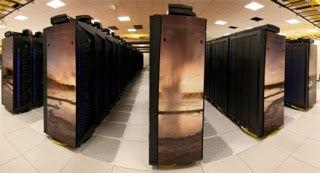Research, papers and presentations are all criteria graduate
school applicants aim for, especially in fields like Chemical Engineering. This
fall, Anthony Richard, a senior at the University of Wyoming, succeeded in completing
all three goals.
 |
| Richard works on the equipment that allows him to study gas hydrates |
Richard, originally from Louisiana, started his research in
the summer of 2011 under Dr. Hertanto Adidharma in the area of gas hydrate
inhibitors. Gas hydrates are similar to ice. They form when water molecules
form a cage and trap a gas molecule inside. This can be dangerous in
transmission pipelines moving oil or gas because gas hydrates plug up pipelines
which can cause equipment failures. In his research, Richard works on
developing inhibitors that will prevent the formation of methane gas hydrates.
This research is a continuation of original research started by Dr. Adidharma.
“I just wanted to do research,” Richard said. “And I really
wanted to work with Dr. Adidharma because he has done a lot of really good work
and he’s a really great professor.”
When Richard approached Dr. Adidharma about research, he was
offered the project about gas hydrate inhibitors. The only thing he needed was
funding. For the summer 2011, Richard applied for the McNair scholarship and
shortly after he applied for the fall 2011 EPSCoR Undergraduate Research Fellowship. Richard received both and was on his way to research, papers and
presentations.
His research paper, The performance of ionic liquids and their mixtures in inhibiting methane hydrate formation, is the result of his hard work, dedication and innovation. The
area of gas hydrate inhibitors is broad. There are multiple types of inhibitors
which prevent gas hydrate formation in one of two ways. Either the inhibitor
changes the conditions of hydrate formation (such as adding something into the
process which stops the prevention of ice at a certain temperature) or the
inhibitor slows down the formation process.
Richard worked with an inhibitor called ionic liquids, which
prevent gas hydrate formation in both ways. Dr. Adidharma was the first to
discover how ionic liquids work as inhibitors and, in his research, Richard
worked on creating a synergy between different kinds of inhibitors. He mixed
together different ionic liquids, mixed ionic liquids with conventional
inhibitors and studied the effect of pressure on ionic liquid inhibition.
In October, Richard presented this research at the annual
American Institute of Chemical Engineers (AIChE) conference in Pittsburgh, PA.
The AIChE conference is one of the biggest in the world for Chemical Engineers.
“Presenting at a big conference has been on my list for
quite a while,” Richard said. And when the opportunity to present came up, he
jumped on it.
Richard gave a twenty minute oral presentation at the
conference, which is rare for undergraduates, who usually give poster
presentations at such conferences. Richard, however, was not worried, as his
experiences with EPSCoR and McNair had given him presentation practice.
“Through McNair and EPSCoR and all the research I’ve been
doing, I’m getting really familiar with this material,” Richard said. “So, presenting
wasn’t that big of a worry. I didn’t mind presenting at all; it was great.”
Richard will graduate from UW this coming May. His graduate
school applications are in and he’s looking forward to continuing research,
either in the area of gas hydrate inhibitors or beyond.
By Kali S. McCrackin
Photo by: Kali S. McCrackin





